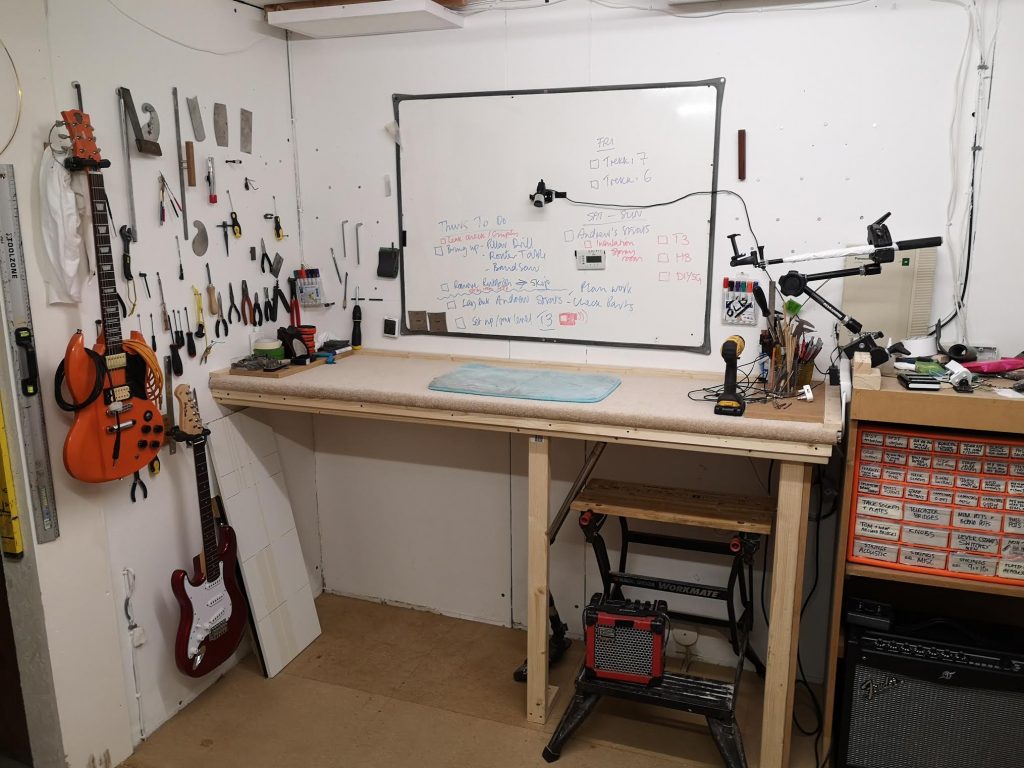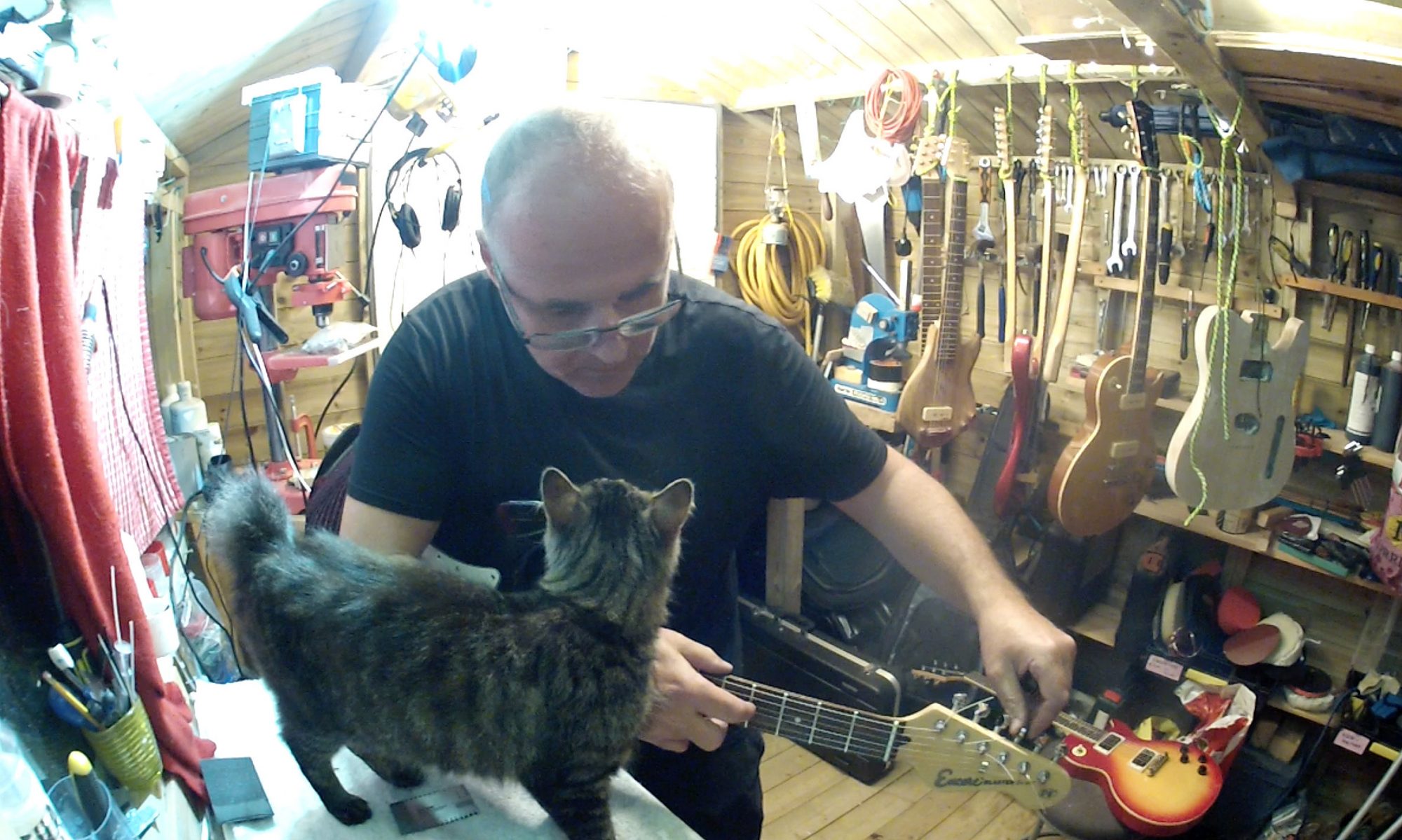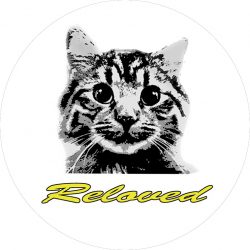
3 weeks after taking possession of the keys the new Reloved Guitars workshop I’ve cleaned it, painted it, climbed over the filthy roof and rigged up buckets to catch leaks, rolled out insulation, laid floorboards, built workbenches and put up shelves. I’ve sprayed some guitars with clear acrylic finish (stuff that couldn’t wait) and done my first paid set up in the new space just this last weekend. There’s a kettle, a water heater for washing up and cleaning things, plenty of space and – because the main room is constructed from the walls of a refrigerated truck – it warms up with body heat alone AND magnets stick to the metal walls. What a bonus! This means that I don’t have to spend a ton trying to heat it (a 15 minute blast with the heater keeps the place warm enough to work for hours) and I can stick all my ‘near-to-hand’ tools right there on the wall where I need them 🙂
I’ve got a couple of my own guitars to play, a newly-acquired 100W Fender amp, a small Roland micro-cube and a DAB radio to keep me entertained. And what don’t we got? We don’t got internet. That’s all.
So three weeks in and I like it. There’s another whole room that I’ve not even started on yet which was a ‘kitchen’ but is likely to become a dedicated spray room. I’ll take my time with that. It’s going to need a thorough clean, a coat of paint and all 3 of my newly-bought rolls of insulation dumping on it’s thin hard-board ceiling. When it’s done (and if I can control the temperature and humidity adequately) then I’ll start using my new Apollo HVLP spray system in there in pursuit of professional-quality finishes for the first time. I’ll also be able to hang guitars and create a space to run the buffer although there will need to be a gap between buffing and spraying as the buffer produces a lot of dust and lint particles. Once the spray room is operational then what is now the ‘temporary spray room’ will become the ‘sawdust / routing’ room and from that point onwards I’ll attempt to isolate the messy woodwork area from the set up, soldering and fretting space and because the spray room is completely separate from the other spaces (with separate doors to vent the fumes through) I should be able to carry on other work without needing to wait for half an hour for the vapours to clear. That’s the plan anyway 🙂
What I’ve learned is pretty simple: 1) don’t be over-ambitious and 2) fake it to make it on those days when you’ve temporarily lost the faith.
1) Don’t be ambitious: part of me thinks that if I’m setting up a new workshop I need to have all the right power tools that I see those other ‘proper’ guitar makers using. Surely it’s not enough *just* to drag my existing tools to a new place and somehow expect it to be better? Well, actually it IS enough. Because the single biggest gain for me in having this particular workshop is the ability to use the tools I currently have any time of the day, any day of the week. And to be able to spray whenever and however often I need to. Those improvements alone will transform what I can do. But I haven’t just dragged across the ‘same old tools’, I’ve also added the Apollo HVLP spray set up. When I had a ‘spare’ £400 in all of the last few months’ uncertainty I risked investing it in this spray unit…because I wanted to add at least ONE significant new capability to Reloved Guitars. So I know how much of a step up this workshop is for me and I’m happy to add just that one single capability… for now.
2) Fake it to make it: there were days when I didn’t think that I’d ever like the feel of this workshop; days when the familiar cosiness of the shed seemed very appealing. So much so that on some days it was all I could do just to make myself go up to the new workshop, dump some tools from the shed, look around a bit and head back home. I even found myself planning to continue using the shed to do set ups until after Christmas… and doing in the workshop only that which couldn’t be done in the shed (guitar modifications, building and spraying). That comforting little self-deception only had to last until I realised that I was quite liking the way it was developing – namely, shortly after building the first workbench and fixing up the ceiling-mounted LED lights. But on those days when my heart wasn’t in it I knew enough to know that the best I could do was to keep doing it; as if I believed in it. As soon as I’d finished the workbench I knew that it didn’t make sense to work in two places at once and I knew that the next set up I did would be in the new workshop, under the bright white lights and talking loudly to the cameras. And so it was!

